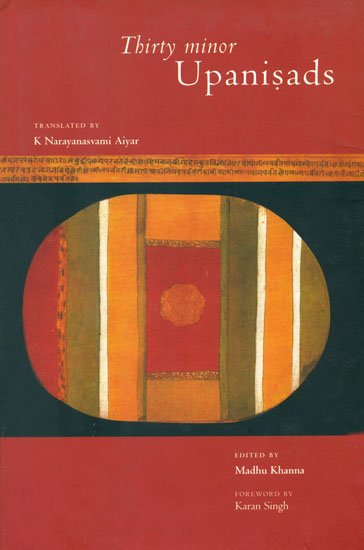Thirty minor Upanishads
by K. Narayanasvami Aiyar | 1914 | 95,228 words
This book contains the English translation of thirty minor Upanishads.—Fourteen belonging to Vedanta, two are categorised as Physiological, three are Mantra, two are Sannyasa and the remaining nine are categorised as Yoga-Upanishads. These Upanishads are properly defined as the Aranya-portion of the Vedas (most ancient Hindu scriptures) and are so-...
Subala Upanishad of Shukla-yajurveda, Chapter I
Then he (Raikva[1]) asked: "What was at first?" To which (He the Lord) replied:
"There was neither Sat[2] nor asat nor Sat-asat. From it, tamas (darkness) was evolved. From tamas came bhūtādi;[3] from bhūtādi came ākāś, from ākāś, vāyu; from vāyu, agni (fire); from agni, āpas (water); and from āpas, pṛthivī (earth). Then it became an egg. After remaining so for one (divine) year, it split into two and became earth below,[4] the ākāś above and in the midst, the infinite Puruṣa of a divine form of myriads of heads, eyes, feet and hands. Prior to the bhūtas (elements), he had evolved Mṛtyu (time or death) of three letters[5], three heads, and three feet, and having a khaṇḍa-paraśu[6] (broken axe). To him, Brahma (the Puruṣa) spoke. He entered Brahma himself and evolved mentally the seven sons[7] and these Havirāts (or sons) as well as the seven prajāpatis (progenitors). Brāhmaṇas[8] were born from His mouth, Kṣattriyas from His hands, Vaiśyas from His thighs, and from the feet were born the Śudras. The moon was born from His manas (mind), the sun from His eyes, vāyu from (His) ears and prāṇas from (His) heart. Thus all things were born."
Footnotes and references:
[1]:
In the Chāndogya Upaniṣad, Raikva is said to be the imparter of Samvargavidyā.
[2]:
The absolute (Parabrahman) is neither Sat (Be-ness) nor asaṭ (not-Be-ness) nor a commingling of both. It is neither spirit nor matter nor a commingling of both.
[3]:
Bhūtādi is tāmasa ahaṅkāra according to Viṣṇu Purāṇa.
[4]:
"Above and below" refers not to the position but only to the state, of matter, gross or subtle. "In the midst" implies that ākāś and earth are soaked in and with spirit.
[5]:
[6]:
[7]:
This refers to the septenary manifestation from the triune one; also to the sub-septenary ones.
